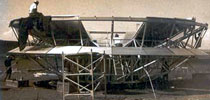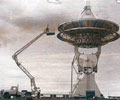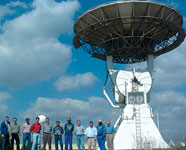
The 40 ft (12,19 m) parabolic antenna of the Council for Scientific and Industrial Research (CSIR) has been providing excellent satellite support services for more than 40 years, dating back to August 1964. It has rescued a $400 million satellite, received data from scientific packages left on the moon by Apollo astronauts, and even tracked the biosatellite capsule with a monkey on board. This gigantic antenna continues to dwarf other antennas at the CSIR Satellite Application Centre (SAC) at Hartebeesthoek.

The high-performance antenna was constructed specifically to receive wide band data reliably from complex scientific orbiting observatories in a variety of earth orbits. Philco Ford in Los Angeles designed and manufactured the antenna on behalf of the NASA's Goddard Space Flight Centre (GSFC).

The 40 ft antenna was one of three such antennae, with the other two being placed at Santiago in Chile and in the Orroral Valley in Australia. Tracking and acquiring data from the first orbiting geophysical observatories (OGO) series commenced in September 1964. When the first OGO satellite was launched, it was aimed to reach as far as 150 000 km into space. This provided a serious challenge to the then yet-to-be-proven 40 ft antenna due to the highly eccentric orbit.

The dish has received more than four million minutes of data during its career from dozens of NASA scientific satellites and was used to support hundreds of NASA launches. It played a crucial role in NASA missions from 1964 to 1975. The last NASA mission performed was to support the Project Viking launches to Mars in October 1975.
After NASA ceased operations in South Africa, the 40 ft feed was modified to receive data from a variety of earth observation satellites, including Meteosat, Noaa, and Landsat. In the early 1980s, the system was modified to support the space activities of the French national space agency (CNES), as it still does today. In recent years, transmitting capabilities were added, which required extensive modification of the feed system.
Still impressive
The giant antenna is still very impressive - the powerful hydraulic drive system can move it at an angular rate of 15° per second in both axes simultaneously, or creep along at sidereal rate, some 4000th of a degree per second. Despite the weight of the parabolic reflector and a heavy feed, the antenna can accelerate at some 15° per second squared.
Dual hydraulic drives on both axes virtually eliminate any mechanical play in the drive train. The antenna can be pointed at any location in the sky with an accuracy of 1000th of a degree - a remarkable ability for such a heavy and manoeuverable dish.
The encoders on either axis are so sensitive they easily detect the effect of solar heating on the structure as the sun rises above the horizon. Because the large parabolic dish will generate temperatures of several hundred degrees at the focus when pointing directly at or near the sun, the sensitive electronics sited there would be destroyed. The parabolic reflector is thus painted with a special dispersive white paint.
The superior 'no-expenses-spared' mechanical design and construction of the 40 ft antenna makes it the Rolls Royce of low earth-orbiting satellite tracking antennae. Unlike the cheaper azimuth over elevation (rotate and tilt) axis construction of modern satellite tracking antennas that cannot track satellites passing directly overhead, the 40-footer, with its X-Y (East-West and North-South) axes, has no difficulty in tracking any satellite above the horizon.
For more information contact the CSIR, +27 (0)12 841 3887, [email protected]

© Technews Publishing (Pty) Ltd | All Rights Reserved